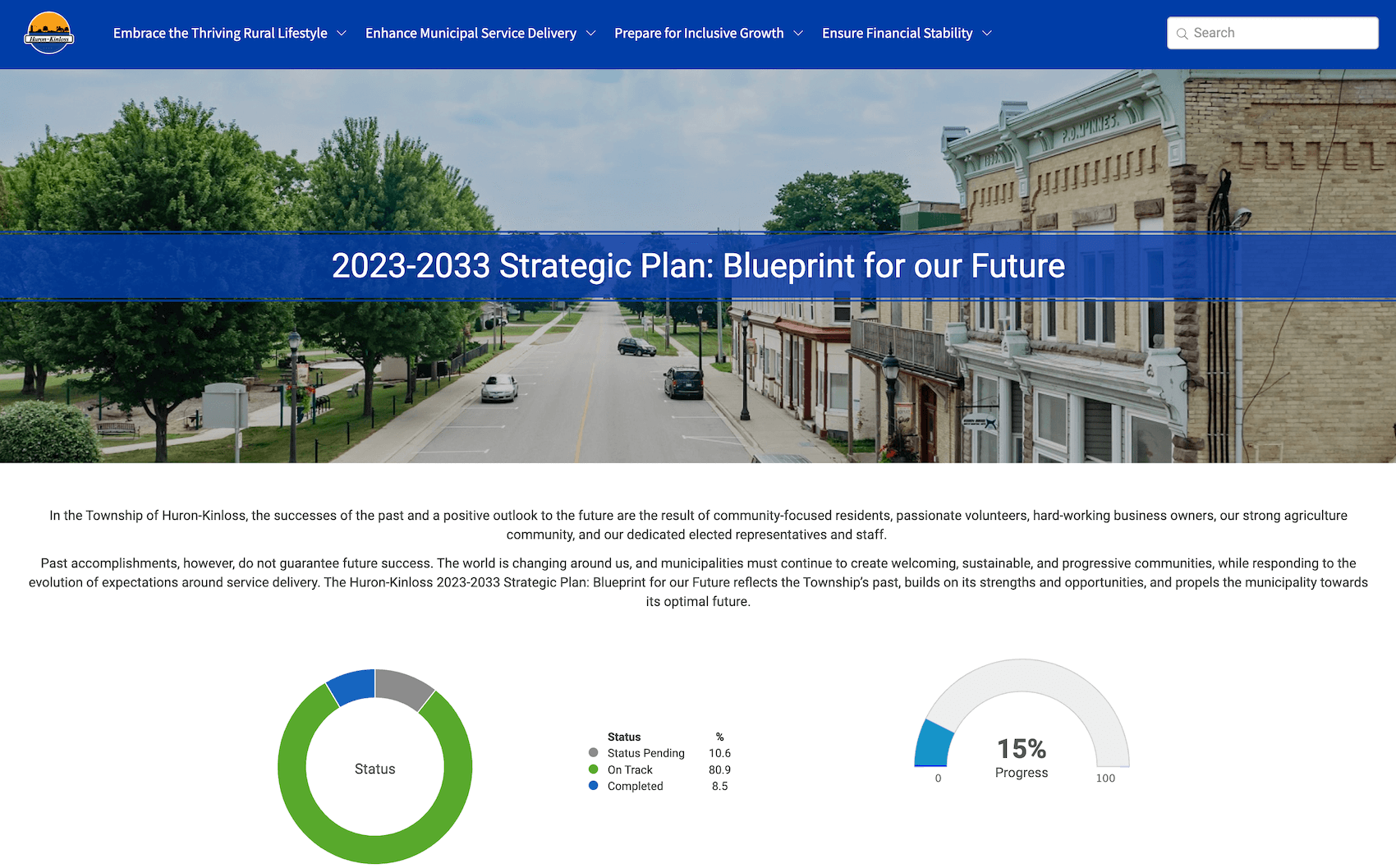Contents
- Municipal priorities should be resident-focused
- Municipal strategic priorities should provide direction
- Municipal assurance is a key part of good municipal strategy
- 5 common municipal strategic priorities
- What are your municipal strategic priorities?
- Schedule a demo ↓
Determining strategic priorities for modern municipalities is tricky work. Every municipality is unique, with its own vision, mission, and values. Each has its own constraints—both politically and economically—varying needs and goals, and unique community members, too.
Modern municipalities have to balance community needs with limited resources, changing economic and political climates, and an ever-growing need for transparency and trust. And while there is a major diversity of needs and methods when it comes to creating or executing strategic priorities, there are common themes across municipalities that we can look to for inspiration. In every case, the best priorities—meaning, the ones that are most likely to be achieved—are the ones that are backed up with robust data.
To effectively guide local government operations, strategic priorities should not only be relevant to the community, but also be achievable, measurable, and resourced by a budget that has been guided by data. Whether these priorities are crafted through extensive community consultation or are the result of careful collaboration among council members and city staff, the importance of ensuring priorities are resourced can’t really be overstated.
Before we jump into 5 of the most common strategic priorities, here are a few traits of a good municipal priority:
Municipal priorities should be resident-focused
Local governments should aim to put the needs of their communities first by ensuring that the strategic priorities they choose address what impacts people’s lives the most! This is often achieved through a combination of surveys, public consultations, and engagement initiatives to gather input from residents.
Municipal strategic priorities should provide direction
The strategic priorities a municipality sets provide the overall direction for its strategic plan. They are the compass for operational work plans and the specific projects, programs, and initiatives delivered by city staff. Choosing the right priorities is essential to driving meaningful progress.
Municipal assurance is a key part of good municipal strategy
A well-developed strategic plan is a promise to the community at large. It assures them that their local government is committed to improving their quality of life in tangible, measurable ways. More importantly, the plan should guide city staff in determining how to allocate resources across programs and services that matter most to the community.
5 common municipal strategic priorities
Here’s a look at 5 of the most common municipal strategic priorities and examples of real steps that local governments are taking to ensuring their priorities are actionable through data-gathering and smart resourcing.
1. Economic development
A thriving, agile, and robust local economy is probably the most obvious municipal strategic priority. Across our customer database, we are noticing municipalities increasingly focusing on:
- Business retention and attraction: Creating an environment where local businesses can thrive while drawing in new investments.
- Job creation: Partnering with local businesses and industries to create employment opportunities for residents.
- Supporting local entrepreneurs: Offering resources and incentives for small businesses and startups to fuel innovation and growth.
- Revenue diversification: Identifying new revenue streams to reduce reliance on property taxes and government grants.
- Sales tax increases: Increasing available resources through sales tax increases. One example of this is The City of Ontario, California, with “Measure Q.” This was a 1% sales tax increase that was approved by the community to fund crucial infrastructure projects and enhance services.
Data-driven business incentivization – Town of Addison, Texas
The Town of Addison, Texas, is dedicated to fostering business growth through a variety of economic development incentives. For example, they’ve established the “Chapter 380 Incentive Program”, which offers business incentives and benefits for either starting a business in Addison, or relocating an existing business to Addison. This program, alongside state and local incentives, provides valuable support for businesses looking to establish or expand in the area.
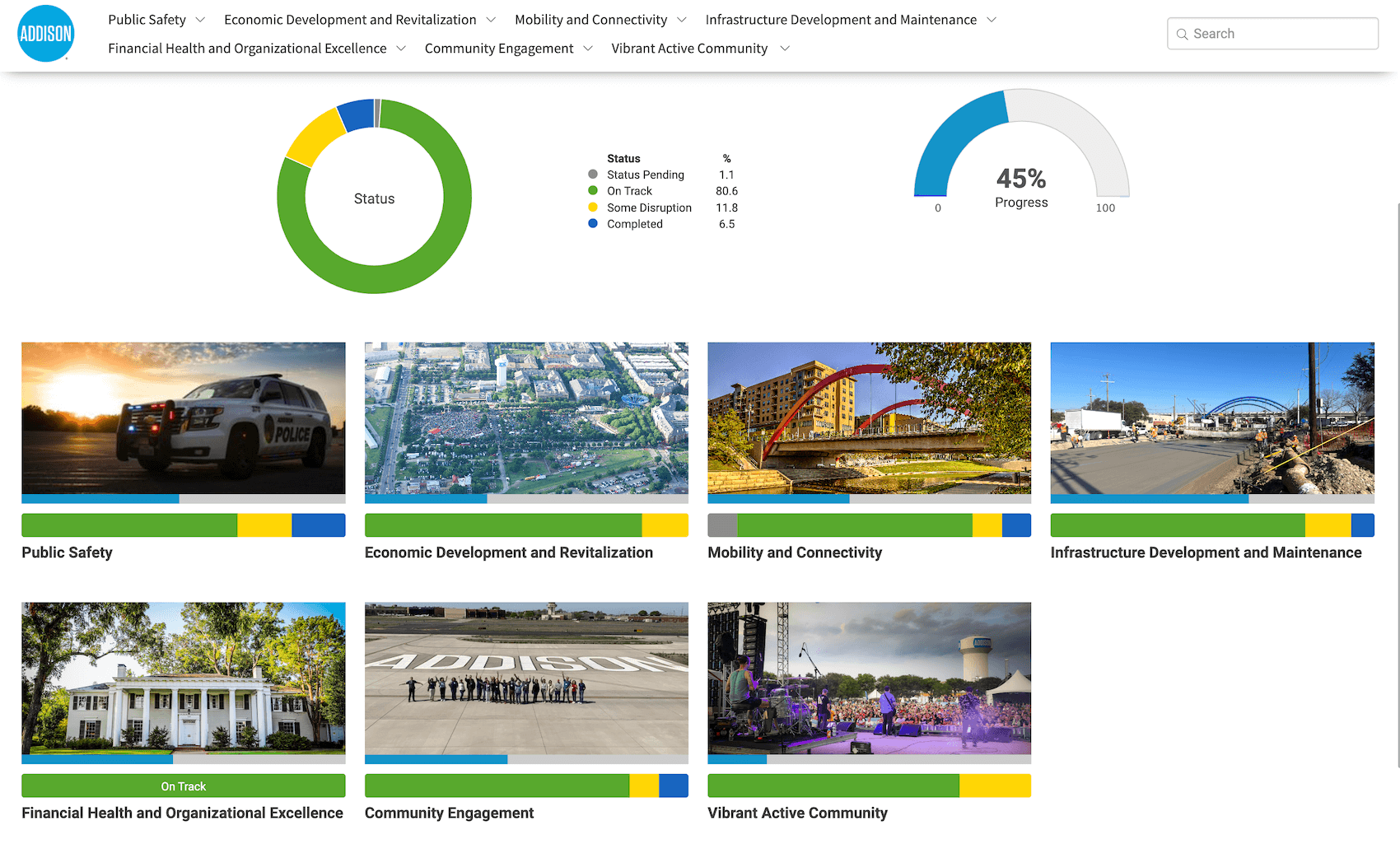
Staff at Addison have also completed the town’s first-ever Community Profile, a comprehensive document showcasing the town’s strengths and potential to attract businesses, investors, and developers. This profile highlights key aspects such as demographics, economic data, infrastructure, real estate, workforce, quality of life, and market access. They are also tracking economic data in their biweekly economic report.
The goal here is for Addison to position itself as a competitive space for prospective developers and businesses.
2. Sustainability and environmental stewardship
As climate change becomes an existential global threat and pressing reality, many municipalities are responding by strategically prioritizing climate adaptation, resilience, and sustainability. Across our customer base, we’ve seen an increase in climate action performance measures and climate action plans, aimed both at reducing the serious impacts of climate action and reducing their carbon footprints.
Common objectives are:
- Reducing carbon emissions: Implementing policies to promote energy efficiency, renewable energy sources, and electric vehicle adoption.
- Waste reduction and recycling: Developing programs to reduce waste, increase recycling rates, and promote a decarbonized economy.
- Preserving green spaces: Protecting parks, forests, and natural areas for future generations while ensuring access to nature for all residents.
Comprehensive heat mapping – The City of Rockville, Maryland
The City of Rockville is prioritizing adaptability and resilience as key components of its strategic climate action plan through collaborative efforts and proactive initiatives. Their approach is comprehensive and multifaceted, but a few standout strategies for using data to enhance resilience are worth highlighting.
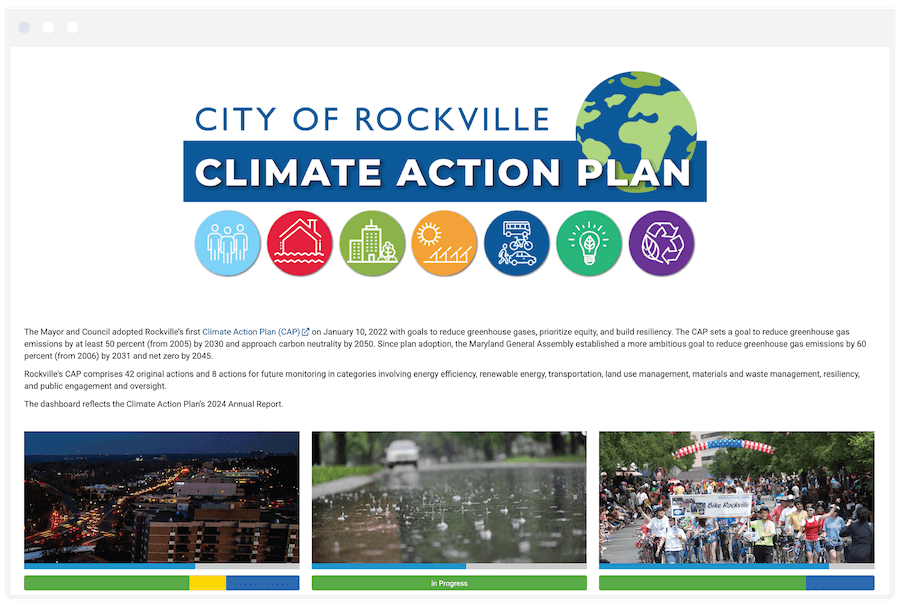
In partnership with Montgomery County and local organizations, Rockville played a pivotal role in an urban heat mapping project funded by a National Oceanic and Atmospheric Administration (NOAA) grant. In August 2022, nearly 600 volunteers equipped with heat sensors mapped temperatures across neighborhoods like Gaithersburg, Germantown, Rockville, Silver Spring, Bethesda, Fairland, and Olney.
This data will guide decisions on tree canopy integration, land use, and heat mitigation efforts. The project focuses on identifying areas most vulnerable to urban heat islands, allowing for targeted mitigation and resource allocation, particularly for at-risk populations such as seniors, infants, outdoor workers, and those without air conditioning.
3. Good governance and engagement
Residents today expect more from their local governments, especially when it comes to engagement and transparency. Municipal strategic priorities in this area often include:
- Open government: Providing easy access to public data, financial reports, and meeting minutes to promote transparency.
- Citizen engagement: Using tools like online surveys, town halls, and social media to gather feedback and involve residents in decision-making.
- Diversity and inclusion: Ensuring that government services and decision-making processes reflect the diversity of the community.
Employee and civic engagement – City of Kirkwood, Missouri
Key goals for the City of Kirkwood, Missouri, include enhancing staff capacity, investing in technology, and fostering collaboration.
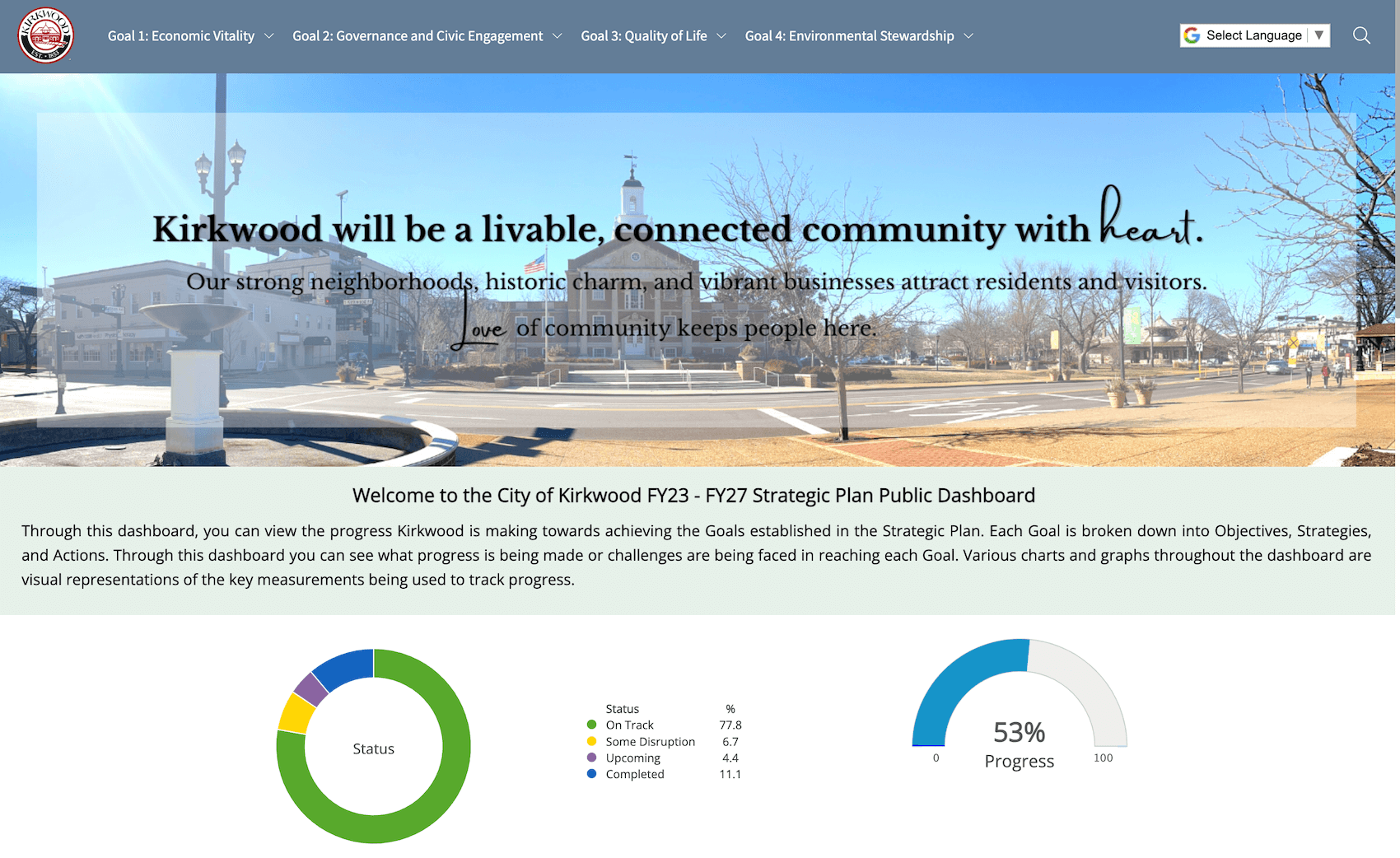
In 2023, the City of Kirkwood prioritized improving service delivery through a salary study, resulting in a new pay schedule for 2024 to ensure competitive compensation for staff.
Efforts also focused on enhancing employee training, knowledge transfer, and implementing new city-wide software. In addition, they have turned attention to strengthening partnerships with regional organizations to improve services such as Parks and Recreation, Police, Fire, and Fleet management.
The city’s new Envisio dashboard is another way the City of Kirkwood team is implementing this strategic priority. The team is using the dashboard to provide current updates on strategic planning goals.
4. Developing community capacity
Capacity building refers to the process of enhancing the abilities, skills, and resources of organizations or communities to achieve their goals and deliver better services.
For many municipal governments, it’s a top priority because it strengthens the effectiveness of local services and fosters community development. This may often involve:
- Technology upgrades: Implementing new software or systems to improve efficiency and service delivery.
- Community engagement initiatives: Encouraging greater public participation in decision-making processes.
- Partnership development: Forming collaborations with regional organizations, nonprofits, or other municipalities for shared services.
- Leadership development programs: Training leaders to effectively manage projects and drive community initiatives.
- Volunteerism support: Offering resources and training to strengthen volunteer networks within the community.
The approach to capacity building can vary significantly between rural and urban communities.
In urban areas, capacity building might focus on improving technological infrastructure, and creating partnerships to handle complex service delivery.
In rural areas, capacity building often focuses on maintaining strong community ties, supporting volunteerism, and building partnerships to compensate for fewer resources. For instance, rural towns may prioritize expanding local healthcare services, developing agricultural programs, or supporting small business growth to boost economic resilience.
Rural capacity building – Township of Huron-Kinloss, Ontario
Rural capacity building is a specific strategic priority that the Township of Huron-Kinloss is embracing. They’re focused on increasing community engagement, supporting volunteerism, and enriching partnerships that enhance the wellbeing of the entire community.
Through initiatives like preparing for changing workforce needs and empowering local groups, Huron-Kinloss fosters a sense of belonging and mutual support among its residents, ensuring that the township grows together while maintaining their own specific rural lifestyle.
5. Public Safety and emergency preparedness
Keeping residents safe is a top priority for any local government. Many municipalities are taking care to implement data-driven practices around:
- Crime reduction: Implementing community policing strategies, technology-driven crime prevention, and youth engagement programs.
- Emergency response readiness: Developing disaster preparedness plans and enhancing coordination with emergency services.
- Public health: Addressing outbreaks of transmittable illnesses, as well as the opioid crisis, mental health, homelessness, and other health issues with a proactive approach.
High-quality public safety services – Yarmouth, Massachusetts
Yarmouth, Massachusetts has a strategic priority specifically called, “High-Quality Public Safety,” which they support through ensuring their public safety agencies have increased teamwork, accountability, and community involvement.
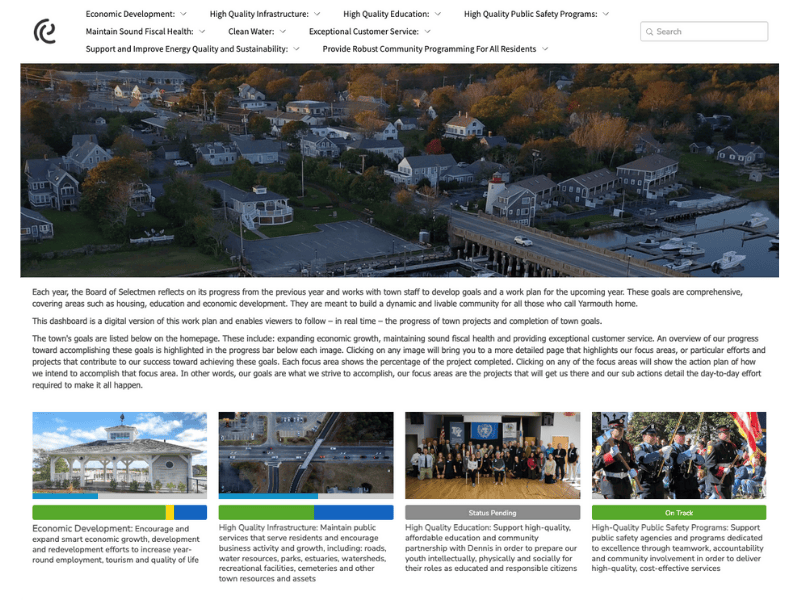
In particular, on their dashboard, they outline their response to the rise in calls related to mental health and opioid addiction. First responders, such as police, are receiving enhanced training in mental health crisis intervention, including Community Crisis Intervention Team (CCIT) protocols, ensuring they are equipped to assist individuals in acute crisis.
The Police Department has also updated its policies on handling mental health cases and established a Mental Health Response Unit, which includes follow-up visits and a part-time civilian clinician. These efforts, supported by grant funding, emphasize Yarmouth’s commitment to delivering compassionate and effective public safety services.
What are your municipal strategic priorities?
These five common strategic priorities—economic development, environmental stewardship, good governance, capacity building, and public safety—are key to shaping effective municipal policy. If you’re developing or updating your city’s strategic plan or Council priorities, these aren’t a bad place to start. And as always, the goal should be to provide clear communication, transparency, accountability, and regular progress updates on these priorities. Strategic priorities form the core of any plan, so selecting them thoughtfully is crucial to your city’s success!
Schedule a demo ↓
At Envisio, we help municipalities track, report, and achieve their strategic priorities. Schedule a free demo with one of our strategy experts to learn how Envisio can help your organization achieve its goals and elevate performance.
Drop us a line to talk about your municipal strategic priorities, and schedule a free demo of Envisio now! We look forward to showing you how we can help you get aligned, and get results.


